sensor Peugeot 508 2011 User Guide
[x] Cancel search | Manufacturer: PEUGEOT, Model Year: 2011, Model line: 508, Model: Peugeot 508 2011Pages: 340, PDF Size: 25.72 MB
Page 133 of 340
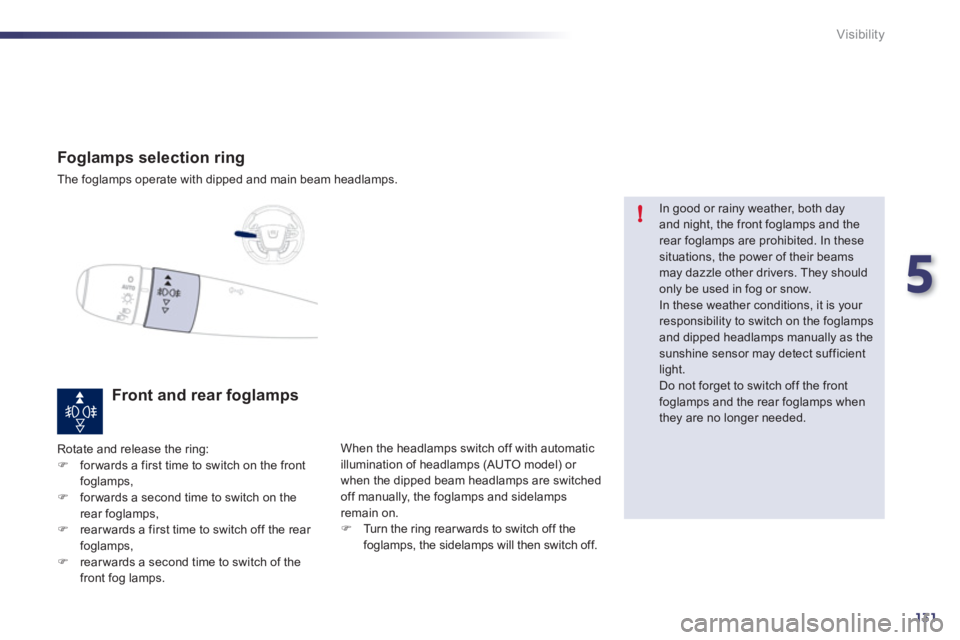
5
131
!
Visibility
Foglamps selection ring
The foglamps operate with dipped and main beam headlamps.
Front and rear foglamps
Rotate and release the ring:
�)
for wards a first time to switch on the front
foglamps,
�)
for wards a second time to switch on the
rear foglamps,
�)
rear wards a first time to switch off the rear
foglamps,
�)
rear wards a second time to switch of the
front fog lamps. When the headlamps switch off with automatic
illumination of headlamps (AUTO model) or
when the dipped beam headlamps are switched
off manually, the foglamps and sidelamps
remain on.
�)
Turn the ring rear wards to switch off the
foglamps, the sidelamps will then switch off.
In good or rainy weather, both day
and night, the front foglamps and the
rear foglamps are prohibited. In these
situations, the power of their beams
may dazzle other drivers. They should
only be used in fog or snow.
In these weather conditions, it is your
responsibility to switch on the foglamps
and dipped headlamps manually as the
sunshine sensor may detect sufficient
light.
Do not forget to switch off the front
foglamps and the rear foglamps when
they are no longer needed.
Page 136 of 340
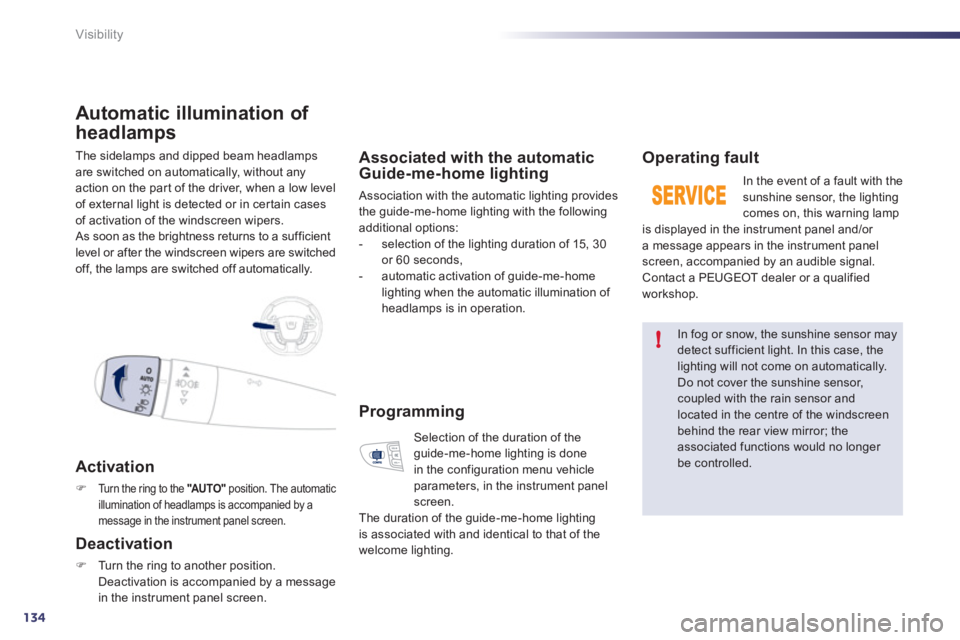
134
!
Visibility
The sidelamps and dipped beam headlamps
are switched on automatically, without any
action on the par t of the driver, when a low level
of external light is detected or in cer tain cases
of activation of the windscreen wipers.
As soon as the brightness returns to a sufficient
level or after the windscreen wipers are switched
off, the lamps are switched off automatically.
Automatic illumination of
headlamps
Activation
�)
Turn the ring to the "AU TO "
position. The automatic
illumination of headlamps is accompanied by a
message in the instrument panel screen.
Deactivation
�)
Turn the ring to another position.
Deactivation is accompanied by a message
in the instrument panel screen.
Associated with the automatic
Guide-me-home lighting
Association with the automatic lighting provides
the guide-me-home lighting with the following
additional options:
- selection of the lighting duration of 15, 30
or 60 seconds,
- automatic activation of guide-me-home
lighting when the automatic illumination of
headlamps is in operation.
Operating fault
In the event of a fault with the
sunshine sensor, the lighting
comes on, this warning lamp
is displayed in the instrument panel and/or
a message appears in the instrument panel
screen, accompanied by an audible signal.
Contact a PEUGEOT dealer or a qualified
workshop.
In fog or snow, the sunshine sensor may
detect sufficient light. In this case, the
lighting will not come on automatically.
Do not cover the sunshine sensor,
coupled with the rain sensor and
located in the centre of the windscreen
behind the rear view mirror; the
associated functions would no longer
be controlled.
Programming
Selection of the duration of the
guide-me-home lighting is done
in the configuration menu vehicle
parameters, in the instrument panel
screen.
The duration of the guide-me-home lighting
is associated with and identical to that of the
welcome lighting.
Page 137 of 340
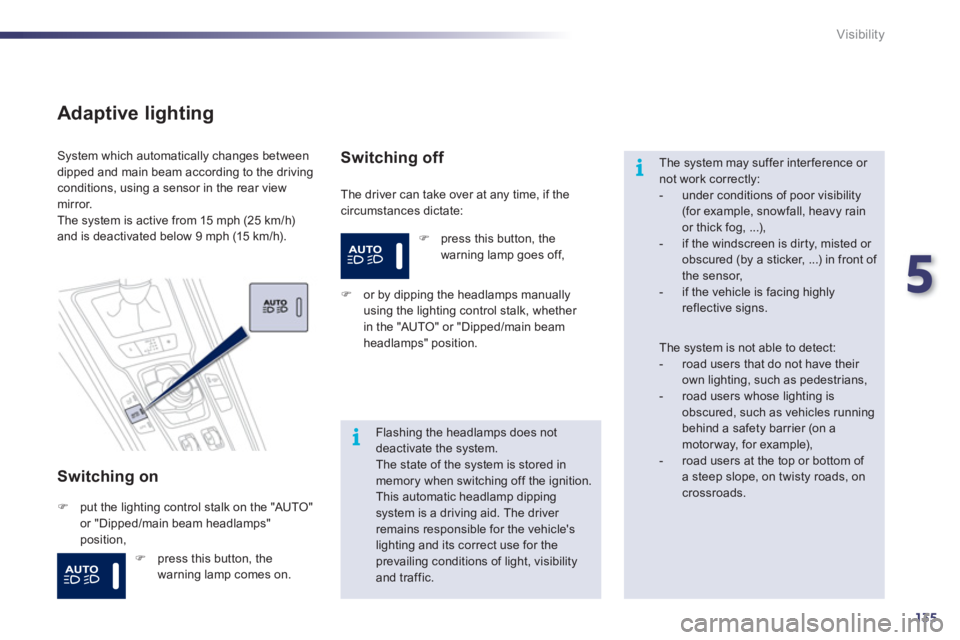
5
135
i
i
Visibility
Adaptive lighting
Switching on
The driver can take over at any time, if the
circumstances dictate: System which automatically changes between
dipped and main beam according to the driving
conditions, using a sensor in the rear view
mirror.
The system is active from 15 mph (25 km/h)
and is deactivated below 9 mph (15 km/h).
�)
put the lighting control stalk on the "AUTO"
or "Dipped/main beam headlamps"
position,
Switching off
�)
or by dipping the headlamps manually
using the lighting control stalk, whether
in the "AUTO" or "Dipped/main beam
headlamps" position.
Flashing the headlamps does not
deactivate the system.
The state of the system is stored in
memory when switching off the ignition.
This automatic headlamp dipping
system is a driving aid. The driver
remains responsible for the vehicle's
lighting and its correct use for the
prevailing conditions of light, visibility
and traffic.
The system may suffer inter ference or
not work correctly:
- under conditions of poor visibility
(for example, snowfall, heavy rain
or thick fog, ...),
- if the windscreen is dir ty, misted or
obscured (by a sticker, ...) in front of
the sensor,
- if the vehicle is facing highly
reflective signs.
The system is not able to detect:
- road users that do not have their
own lighting, such as pedestrians,
- road users whose lighting is
obscured, such as vehicles running
behind a safety barrier (on a
motor way, for example),
- road users at the top or bottom of
a steep slope, on twisty roads, on
crossroads.
�)
press this button, the
warning lamp goes off,
�)
press this button, the
warning lamp comes on.
Page 138 of 340
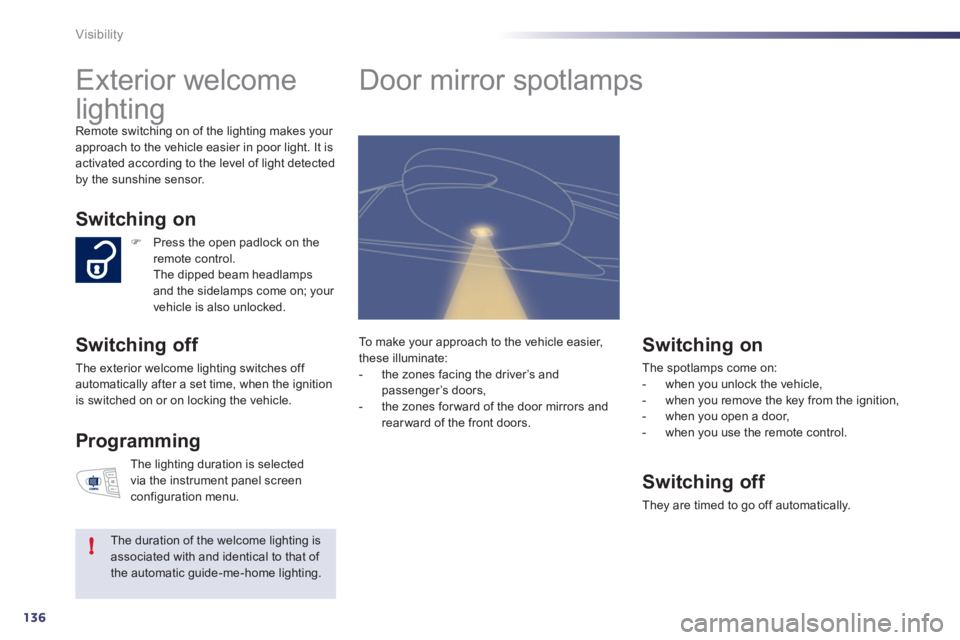
136
!
Visibility
Exterior welcome
lighting
Remote switching on of the lighting makes your
approach to the vehicle easier in poor light. It is
activated according to the level of light detected
by the sunshine sensor.
Switching on
Switching off
The exterior welcome lighting switches off
automatically after a set time, when the ignition
is switched on or on locking the vehicle.
Programming
The lighting duration is selected
via the instrument panel screen
configuration menu.
The duration of the welcome lighting is
associated with and identical to that of
the automatic guide-me-home lighting.
�)
Press the open padlock on the
remote control.
The dipped beam headlamps
and the sidelamps come on; your
vehicle is also unlocked.
Door mirror spotlamps
Switching on
The spotlamps come on:
- when you unlock the vehicle,
- when you remove the key from the ignition,
- when you open a door,
- when you use the remote control.
Switching off
They are timed to go off automatically. To make your approach to the vehicle easier,
these illuminate:
- the zones facing the driver’s and
passenger’s doors,
- the zones for ward of the door mirrors and
rear ward of the front doors.
Page 144 of 340
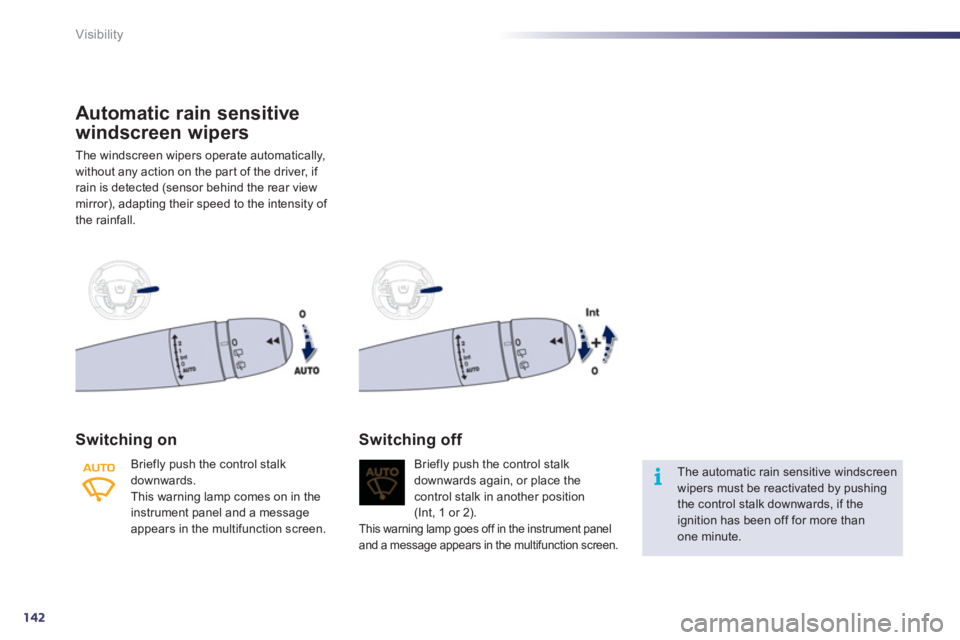
142
i
Visibility
Automatic rain sensitive
windscreen wipers
The windscreen wipers operate automatically,
without any action on the par t of the driver, if
rain is detected (sensor behind the rear view
mirror), adapting their speed to the intensity of
the rainfall.
Switching on
Briefly push the control stalk
downwards.
This warning lamp comes on in the
instrument panel and a message
appears in the multifunction screen. Briefly push the control stalk
downwards again, or place the
control stalk in another position
(Int, 1 or 2).
This warning lamp goes off in the instrument panel
and a message appears in the multifunction screen.
Switching off
The automatic rain sensitive windscreen
wipers must be reactivated by pushing
the control stalk downwards, if the
ignition has been off for more than
one minute.
Page 145 of 340
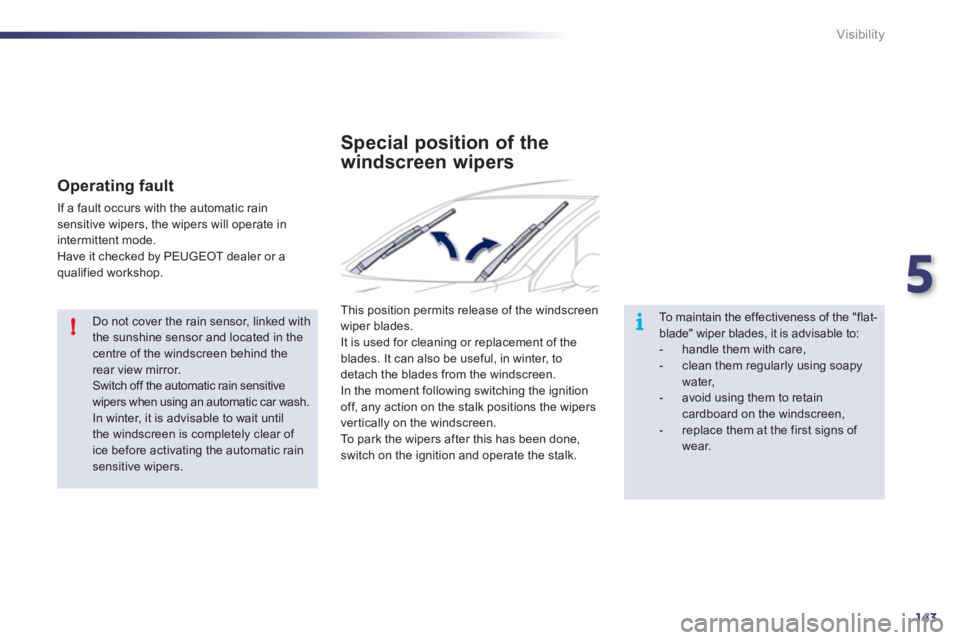
5
143
!i
Visibility
Do not cover the rain sensor, linked with
the sunshine sensor and located in the
centre of the windscreen behind the
rear view mirror.
Switch off the automatic rain sensitive
wipers when using an automatic car wash.
In winter, it is advisable to wait until
the windscreen is completely clear of
ice before activating the automatic rain
sensitive wipers.
Operating fault
If a fault occurs with the automatic rain
sensitive wipers, the wipers will operate in
intermittent mode.
Have it checked by PEUGEOT dealer or a
qualified workshop.
Special position of the
windscreen wipers
This position permits release of the windscreen
wiper blades.
It is used for cleaning or replacement of the
blades. It can also be useful, in winter, to
detach the blades from the windscreen.
In the moment following switching the ignition
off, any action on the stalk positions the wipers
ver tically on the windscreen.
To park the wipers after this has been done,
switch on the ignition and operate the stalk. To maintain the effectiveness of the "flat-
blade" wiper blades, it is advisable to:
- handle them with care,
- clean them regularly using soapy
water,
- avoid using them to retain
cardboard on the windscreen,
- replace them at the first signs of
wear.
Page 161 of 340
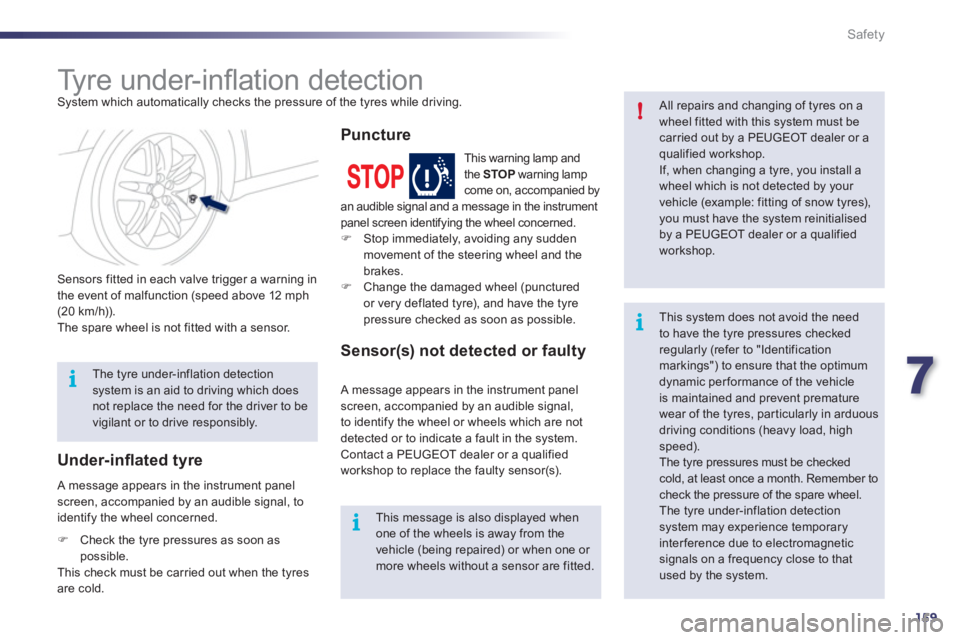
7
159
i!
i
i
Safety
Ty r e u n d e r - i nfl ation detection
System which automatically checks the pressure of the tyres while driving.
Sensors fitted in each valve trigger a warning in
the event of malfunction (speed above 12 mph
(20 km/h)).
The spare wheel is not fitted with a sensor.
All repairs and changing of tyres on a
wheel fitted with this system must be
carried out by a PEUGEOT dealer or a
qualified workshop.
If, when changing a tyre, you install a
wheel which is not detected by your
vehicle (example: fitting of snow tyres),
you must have the system reinitialised
by a PEUGEOT dealer or a qualified
workshop.
This message is also displayed when
one of the wheels is away from the
vehicle (being repaired) or when one or
more wheels without a sensor are fitted.
The tyre under-inflation detection
system is an aid to driving which does
not replace the need for the driver to be
vigilant or to drive responsibly.
This system does not avoid the need
to have the tyre pressures checked
regularly (refer to "Identification
markings") to ensure that the optimum
dynamic per formance of the vehicle
is maintained and prevent premature
wear of the tyres, particularly in arduous
driving conditions (heavy load, high
speed).
The tyre pressures must be checked
cold, at least once a month. Remember to
check the pressure of the spare wheel.
The tyre under-inflation detection
system may experience temporary
inter ference due to electromagnetic
signals on a frequency close to that
used by the system.
A message appears in the instrument panel
screen, accompanied by an audible signal, to
identify the wheel concerned.
Under-infl ated tyre
This warning lamp and
the STOP
warning lamp
come on, accompanied by
an audible signal and a message in the instrument
panel screen identifying the wheel concerned.
�)
Stop immediately, avoiding any sudden
movement of the steering wheel and the
brakes.
�)
Change the damaged wheel (punctured
or very deflated tyre), and have the tyre
pressure checked as soon as possible.
Puncture
A message appears in the instrument panel
screen, accompanied by an audible signal,
to identify the wheel or wheels which are not
detected or to indicate a fault in the system.
Contact a PEUGEOT dealer or a qualified
workshop to replace the faulty sensor(s).
Sensor(s) not detected or faulty
�)
Check the tyre pressures as soon as
possible.
This check must be carried out when the tyres
are cold.
Page 180 of 340
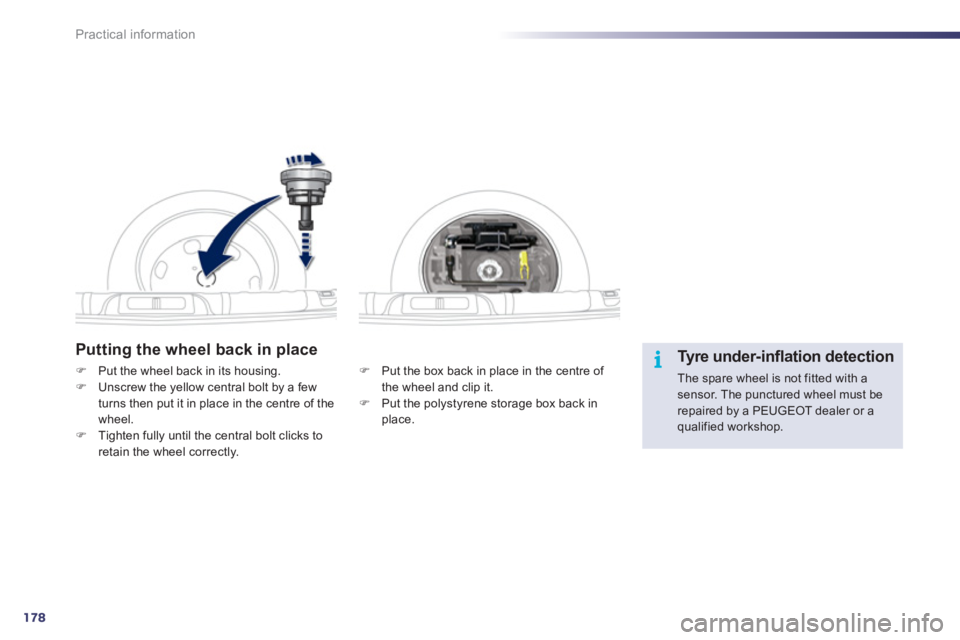
178
i
Practical information
Putting the wheel back in place
�)
Put the box back in place in the centre of
the wheel and clip it.
�)
Put the polystyrene storage box back in
place.
�)
Put the wheel back in its housing.
�)
Unscrew the yellow central bolt by a few
turns then put it in place in the centre of the
wheel.
�)
Tighten fully until the central bolt clicks to
retain the wheel correctly.
Ty r e u n d e r - i nfl ation detection
The spare wheel is not fitted with a
sensor. The punctured wheel must be
repaired by a PEUGEOT dealer or a
qualified workshop.
Page 205 of 340
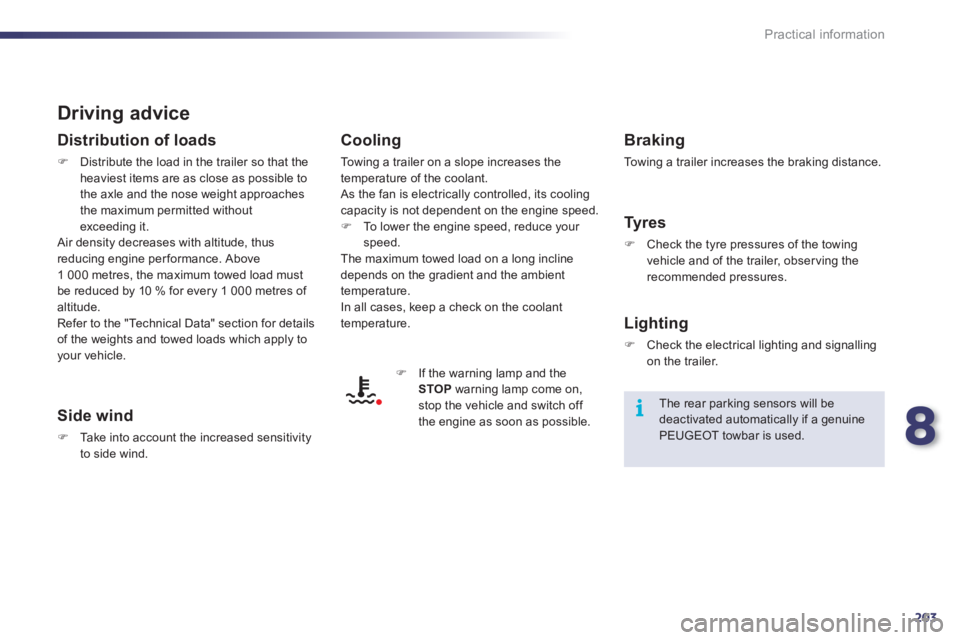
8
203
i
Practical information
Driving advice
Distribution of loads
�)
Distribute the load in the trailer so that the
heaviest items are as close as possible to
the axle and the nose weight approaches
the maximum permitted without
exceeding it.
Air density decreases with altitude, thus
reducing engine per formance. Above
1 000 metres, the maximum towed load must
be reduced by 10 % for every 1 000 metres of
altitude.
Refer to the "Technical Data" section for details
of the weights and towed loads which apply to
your vehicle.
Side wind
�)
Take into account the increased sensitivity
to side wind.
Cooling
Towing a trailer on a slope increases the
temperature of the coolant.
As the fan is electrically controlled, its cooling
capacity is not dependent on the engine speed.
�)
To lower the engine speed, reduce your
speed.
The maximum towed load on a long incline
depends on the gradient and the ambient
temperature.
In all cases, keep a check on the coolant
temperature.
�)
If the warning lamp and the
STOP
warning lamp come on,
stop the vehicle and switch off
the engine as soon as possible.
Braking
Towing a trailer increases the braking distance.
Ty r e s
�)
Check the tyre pressures of the towing
vehicle and of the trailer, obser ving the
recommended pressures.
Lighting
�)
Check the electrical lighting and signalling
on the trailer.
The rear parking sensors will be
deactivated automatically if a genuine
PEUGEOT towbar is used.
Page 207 of 340
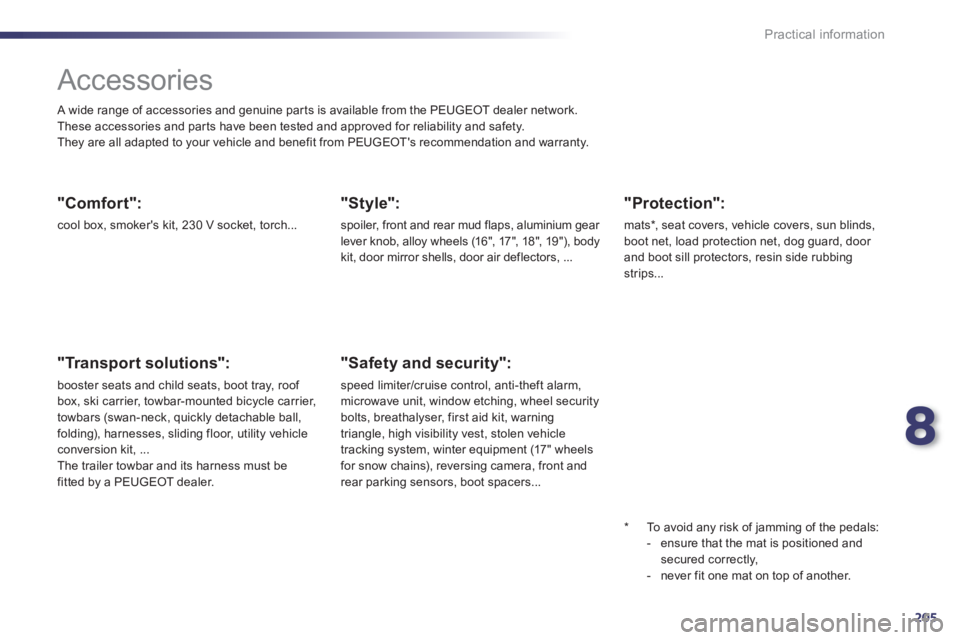
8
205
Practical information
Accessories
A wide range of accessories and genuine par ts is available from the PEUGEOT dealer network.
These accessories and par ts have been tested and approved for reliability and safety.
They are all adapted to your vehicle and benefit from PEUGEOT's recommendation and warranty.
"Comfort":
cool box, smoker's kit, 230 V socket, torch...
"Transport solutions":
booster seats and child seats, boot tray, roof
box, ski carrier, towbar-mounted bicycle carrier,
towbars (swan-neck, quickly detachable ball,
folding), harnesses, sliding floor, utility vehicle
conversion kit, ...
The trailer towbar and its harness must be
fitted by a PEUGEOT dealer.
"Style":
spoiler, front and rear mud flaps, aluminium gear
lever knob, alloy wheels (16", 17", 18", 19"), body
kit, door mirror shells, door air deflectors, ...
*
To avoid any risk of jamming of the pedals:
- ensure that the mat is positioned and
secured correctly,
- never fit one mat on top of another.
"Safety and security":
speed limiter/cruise control, anti-theft alarm,
microwave unit, window etching, wheel security
bolts, breathalyser, first aid kit, warning
triangle, high visibility vest, stolen vehicle
tracking system, winter equipment (17" wheels
for snow chains), reversing camera, front and
rear parking sensors, boot spacers...
"Protection":
mats * , seat covers, vehicle covers, sun blinds,
boot net, load protection net, dog guard, door
and boot sill protectors, resin side rubbing
strips...